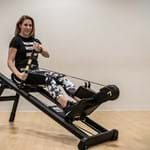No one has been enjoying the pandemic more than dogs. With many owners working from home, most dogs have enjoyed lots of human time and been out for more walks than ever.
Throughout the pandemic people laced up their shoes and started walking when public health measures were at their strictest. Suddenly everyone was out walking with their dog(s), and some even took in foster dogs from shelters and rescue groups.
It took a pandemic to learn what dog owners have known for a while…owning a dog can prompt you to be more active and helps improve mental health. Studies show dog owners spend close to 300 minutes each week walking their dogs, about 200 more minutes of walking than those who don’t own dogs.
But all that extra walking can take its toll if you’re not ready, and especially if you have a larger, or high-energy pooch. How many times have you been pulled down the stairs by a dog eager to get outside, or tripped over a four-legged friend in your path? Injuries typically happen when a dog pulls on a leash and walkers lose their balance. Hip fractures were the most common injury associated with dog walking, followed by wrist and upper arm fractures.
While walking your dog is good, we still need to work on exercises to improve our balance and build muscle so we can enjoy our dog time more and minimize the risk of injury. On National Pet Day (April 11) it’s time to show some love to our dogs, and ourselves.
Training for better dog walks
Here are some great functional exercises you can do at the gym or at home to help build strength and stability to prevent injury and enjoy your dog time more.
Stabilize your core: A strong core helps you walk on uneven terrain and stay upright when your dog pulls or jumps. Try planks, glute bridges, and supermans (lie on your stomach and slowly lift shoulders and thighs off the ground, hold, then release).
Strengthen your ankles: With all the walking and running after your dog, there’s a risk of rolling your ankle. Opt for exercises that require you to balance on one leg at a time like the tree pose or half-moon pose in yoga, as well as squat jumps to reinforce ankle stability and help you stay more grounded.
Build shoulders, arms: You need flexibility and strength in your upper body for throwing the ball, holding the leash, and loading the dog into the car. Simple movements like single arm rows with weights, push-ups, or simply alternate raising a full water bottle in front of you at shoulder level, complete 10-15 reps each. These can help stabilize your shoulders and strengthen your upper arms.
Build quads and glutes: For stronger upper legs and glutes to keep up with your pooch, try squats with resistance bands, leg curls on an exercise ball, and side-steps using a resistance band.
Workout WITH your dog
There are lots of exercises you can do with your dog that will give you a chance to build strength, keep your dog engaged, and help teach obedience. Here are some ideas:
- Push-ups on a picnic table or on the ground with your dog in a sit
- Alternate walking, then jogging then sprinting
- Several 30-second planks with your dog lying down nearby
- Walking lunges with your dog heeling beside you
- Dog yoga. The dog reads your energy and it calms them. Good for bonding.
Shake up your routine at least once a week, whether it’s a new route or a new exercise regimen like classes. But remember to consult your vet to figure out what’s best for your dog.
